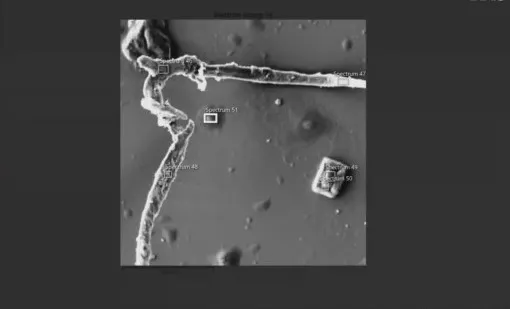
After reviewing electron microscope images of elements contained in the Covid Pfizer and Moderna injections, Dr. Daniel Nagase revealed that, strangely, the contents of the Pfizer and Moderna “vaccines” show no signs of biological material, including mRNA or DNA.
Dr. Nagase is a Canadian emergency room doctor who was put on involuntary leave for successfully treating Covid patients with ivermectin in a central-Alberta hospital in 2021. He has since been touring through Alberta and British Columbia (“BC”) speaking at rallies on treatment options for Covid. Nagase said he has also been “learning a lot about the legal system” while reviewing the medical records of people whose family members believe have died as a result of the “vaccines.”
In the video below Dr. Nagase discusses his findings with Melanie Risdon, a reporter with the Western Standard.
Dr. Nagase was able to obtain samples of both Pfizer and Moderna Covid injections. “Unfortunately, both these samples had to travel for an extensive period of time in various vehicles. So, they’ve been unrefrigerated for up to two months. I don’t know exactly how long they’ve been left unrefrigerated,” he said.
Initially, the research group looked at these Moderna and Pfizer samples under a regular microscope. Although there were a lot of very interesting images, they were unable to be conclusive about what exactly they were seeing. So, they used an electron microscope to determine what elements the “vaccines” contained.
“You would expect to see carbon, oxygen, nitrogen, and phosphorus – all the things you would normally see in a protein,” he said. The team of researchers found carbon and oxygen but none of the samples contained nitrogen or phosphorous.
“X-ray spectroscopy didn’t detect any nitrogen or phosphorus. So, if those complex shapes – that rectangle with all the dots arranged in a grid – were the result of some kind of biological process … then there should be nitrogen and phosphorus there in addition to carbon and oxygen. Because every living thing, whether it’s a virus, plant or animal, is made up of proteins that contain nitrogen, carbon, oxygen, and phosphorus.”
And electron microscopy revealed the same, no nitrogen and no phosphorous.
“[This] particular Moderna sample from somewhere in Canada has no RNA in it. It has no mRNA. Or if there was mRNA in it, somehow it disappeared after being left unrefrigerated for anywhere from one to two months,” he said.
Dr. Nagase examined a “ball with the legs growing out of it” found inside a Moderna sample. “This shape, this ball with the legs growing out of it, for some reason has aluminium in it. And I can say with certainty that this isn’t a mould spore or some other type of biological contamination, because the only thing in it is carbon, oxygen, and no signs of nitrogen, no signs of phosphorus, which would indicate something biological of origin. So, this thing that’s growing is non-biological.”

This confirms what Polish biologist and geologist Dr. Franc Zalewksi discovered last year about what he called a “something” or a “thing” and was later called a “nano-octopus” by La Quinta Columna.
“It seems to have one head and three legs. I did some tests and here are the results: aluminium, bromine and carbon,” Dr. Zalewski said. He established that the head of the “thing” was made of aluminium.
A surprising and new discovery that Dr. Nagase and the researchers made was an unusual element from the lanthanide series – thulium – in a fibre-like structure found in a Pfizer sample.

According to Wikipedia, as edited 20 April 2022, “thulium is the second-least abundant of the lanthanides … It is an easily workable metal with a bright silvery-grey lustre. It is fairly soft and slowly tarnishes in air. Despite its high price and rarity, thulium is used as the radiation source in portable X-ray devices, and in some solid-state lasers. It has no significant biological role and is not particularly toxic … it is never found in nature in pure form, but it is found in small quantities in minerals with other rare earths … The principal sources today are the ion adsorption clays of southern China.”
Dr. Nagase and the researchers found a variety of shapes and structures inside the “vaccine” samples they tested – crystals, chips, strands, bulbs, spheres, fibres and balls with legs growing out of them – “we have polymorphic, which is many different forms,” he said.
“They all seem to be made predominantly out of carbon and oxygen and they were in both the Moderna and Pfizer samples, and they seem to be in fibre forms. In the Moderna sample, the carbon-oxygen structures seem to be taking nanosphere forms and crystalline forms. And in the Pfizer sample … seem to only be forming fibres and crystals.
“So again, what are all these things doing? Carbon-oxygen can certainly be a sign that there’s graphene in it but how do they make graphene take all these different shapes: from spheres to fibres to crystals, this is a technology that I am not aware of with my scientific knowledge.
“I don’t even know if this carbon technology, this carbon nanotechnology is in every batch or is it just in the batches they sent to Canada? Is Canada one half of an experiment and certain States in the US are getting a slightly different batch without the carbon nanotech? And then are countries around the world being given different injections, and we’re being observed to see, ‘well, who dies the fastest, who gets the sickest or what kind of illnesses result’ from experimental ingredients being indiscriminately and without disclosure being given to people?”
Click on the image below to watch Dr, Nagase’s presentation on Rumble.
The transcript of Dr. Nagase’s presentation, including images of his slides, is attached below.
Transcript-Dr.-Daniel-Nagase
